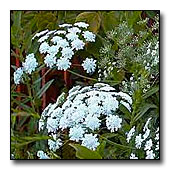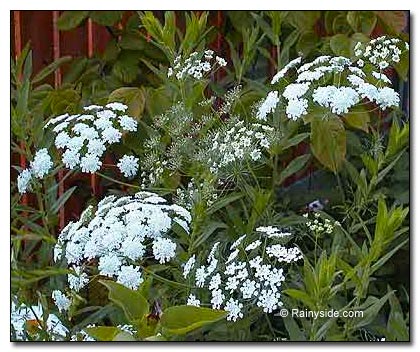Ammi majus
BISHOP'S WEED, FALSE QUEEN ANNE'S LACE, BULLWORT, LACE FLOWER
Family: Apiaceae
Pronounced: AH-mee MAY-jus

Quick Jumps
Growing Guide
Rainy Side Notes
GROWING GUIDE

Origin:
Southern Europe, Turkey and North Africa.
Plant Group:
Annual.
Mature size:
Height: 12-36 inches (30-90 cm).
Width: 12 inches (30 cm).
Flowering period:
Summer.
Flowering attributes:
Compound umbels bearing about 10 small white flowers per umbel, resembling lace work.
Leaf attributes:
Two to three pinnate, light green, lance-shaped leaves.
Light:
Full sun to partial shade.
Soil:
Moist, well-drained, fertile soil is best, but will grow on a variety of soils.
Feeding:
Add a complete organic fertilizer when planting.
Propagation Methods:
Sow seed in situ in spring. To get an early start, sow seed indoors in April. Cover seed lightly. Germinate at temperatures of 68-72° F (20-22° C). Germination will normally occur within 10-14 days. Harden seedlings off and plant outdoors after last frost.
Pests and Diseases:
Susceptible to: Anthriscus, Caraway latent nepovirus, Parsley green mottle potyvirus, Parsnip leaf curl virus. I have not seen this to be a problem in my garden.
Rainy Side Notes
Ammi majus is sometimes confused with roadside Queen Anne's lace, Daucus carota. D. carota is a common weed in the US, and considered a pest in some areas.
A. majus is used in the florist trade to add a lacy delicate look to bouquets and lasts 3-10 days as a cut flower. Cut flowers in the morning with 80% of flowers opened for best results. For dried flowers, air dry flowers for two to three weeks in a dark, dry place. Darkness is necessary so the white flowers do not turn brown.
This annual is used as a diuretic and has antispasmodic properties. A. majus is commonly used as a cardiac tonic for treatment of angina, palpitations or weakness. It is also used in treatment of wheezing or cough. The ancient Egyptians used it as a treatment for skin diseases. Medical research labs are testing A. majus, as it is showing promise in cancer and AIDS therapy.
Be careful handling any plants in the genus, Ammi, as the sap may bring about a skin rash or irritation that can be very serious and painful. The photoactive compounds from Ammi can cause blistering to normal skin when exposed to the sun. Wash the skin area that is exposed to the sap, using soap and water. If symptoms occur after contact with plant, call your local Poison Control Center.
Bishop's weed is also used as an aromatic spice that has a flavor of thyme. For me, I use this for a lacy flower for bouquets. I love the delicate look it gives to the garden.
Debbie Teashon
Photographed in author's garden.

Gardening for the Homebrewer: Grow and Process Plants for Making Beer, Wine, Gruit, Cider, Perry, and More
By co-authors Debbie Teashon (Rainy Side Gardeners) and Wendy Tweton
Copyright Notice | Home | Search | Annuals

